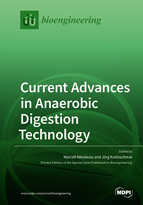Current Advances in Anaerobic Digestion Technology
A special issue of Bioengineering (ISSN 2306-5354).
Deadline for manuscript submissions: closed (30 June 2020) | Viewed by 92009
Special Issue Editors
Interests: anaerobic digestion; biogas; methanogenesis; mixed cultures; enrichment cultures; environmental biotechnology; waste biorefinery; biomimicry; gut microbiology
Special Issues, Collections and Topics in MDPI journals
Interests: (bio)electrochemistry; environmental biotechnology; anaerobic digestion; biogas; biofuels; process monitoring; simulation
Special Issues, Collections and Topics in MDPI journals
Special Issue Information
Dear Colleagues,
Biomass degradation under anoxic conditions includes a variety of natural microbial processes, which have a long tradition of biotechnological utilization. Anaerobic digestion (AD), for instance, has been used for decades to treat various waste streams and to produce methane-rich biogas as an important energy carrier from various wastes and crops. AD is a popular, mature technology, and our knowledge about the influencing process parameters as well as about the diverse microbial communities involved in the process has increased dramatically over the last few decades.
However, the AD sector also faces current challenges, such as feedstock availability and price increases, competitiveness of the products, as well as a lack of process monitoring and automation technologies. Germany is one of the European leaders in biogas technology, regarding the number of large-scale plants and their installed capacity. The produced biogas is mainly used for electricity and heat production. Although more than 8000 German biogas plants still enjoy the generous national subsidy system, this support will be phased out soon, and they have to cope with increasing substrate prices, competition with other renewables, and the requirements of the energy market (e.g., demand oriented power production).
On the other hand, AD offers so much more than biogas alone, and the metabolic flexibility of AD can be the answer to the current challenges. A great variety of substrates can be utilized for AD, including gaseous ones, such as syngas, for example from biomass gasification or hydrogen obtained by the electrolysis of water using electricity from other renewables. AD can be combined with new (bio)technologies, such as (bio)electrochemical technologies, to enhance the efficiency of the process. The product spectrum can also be diversified by shifting AD to anaerobic fermentation, which will lead to the production of carboxylates with a higher economic value. Chemical building blocks can also be obtained by converting methane to methanol, or higher value single-cell proteins can be produced by methanotrophic bacteria. Academic knowledge about the microbiome, the engine driving the AD process, has been accumulating, but the use of this knowledge for the innovation of AD technologies is scarce.
This Special Issue of Bioengineering will publish research articles and review papers dealing with the current advances in the fascinating process of anaerobic digestion and its related processes.
Dr. Marcell Nikolausz
Dr. Jörg Kretzschmar
Guest Editors
Manuscript Submission Information
Manuscripts should be submitted online at www.mdpi.com by registering and logging in to this website. Once you are registered, click here to go to the submission form. Manuscripts can be submitted until the deadline. All submissions that pass pre-check are peer-reviewed. Accepted papers will be published continuously in the journal (as soon as accepted) and will be listed together on the special issue website. Research articles, review articles as well as short communications are invited. For planned papers, a title and short abstract (about 100 words) can be sent to the Editorial Office for announcement on this website.
Submitted manuscripts should not have been published previously, nor be under consideration for publication elsewhere (except conference proceedings papers). All manuscripts are thoroughly refereed through a single-blind peer-review process. A guide for authors and other relevant information for submission of manuscripts is available on the Instructions for Authors page. Bioengineering is an international peer-reviewed open access monthly journal published by MDPI.
Please visit the Instructions for Authors page before submitting a manuscript. The Article Processing Charge (APC) for publication in this open access journal is 2700 CHF (Swiss Francs). Submitted papers should be well formatted and use good English. Authors may use MDPI's English editing service prior to publication or during author revisions.








